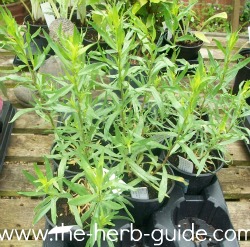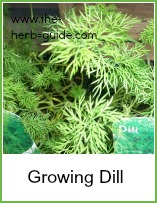- The Herb Guide Home
- Growing Herbs
- Growing Tarragon
Growing Tarragon
As an Amazon Associate I earn from qualifying purchases

Growing tarragon is quite easy.
It is more or less hardy in most climates and is perennial - grows every year from the same roots, dying down in the winter and coming back to life in spring. So once you've got it established, it will come back year after year.
It needs sun and shelter - growing to about 2 feet tall it isn't a small plant, but it's not massive either.

You can try a sample lesson to help you decide if the Herbal Academy of New England is the right choice for you - follow the link below.
Put tarragon in the middle of your herb bed where it will benefit from the shelter of other growing herbs.
Good soil drainage is needed as it won't like to have wet, cold roots during the winter - put some fine gravel in the planting hole which will help a little as the water will drain away quicker.
Divide it and replant it every few years so that it will maintain its flavor. If you go to the Growers Dictionary, that will explain how to divide plants. It does have a tendency to deteriorate as a plant over time, so by dividing it, you'll maintain a strong, healthy plant.
There are many culinary uses for french tarragon. The strong sweetish taste means that you need to use it sparingly.
Try with steaks, mushrooms, omelettes, sauce tartare, grilled fish and flavoring vinegar.
Tarragon butter would be a fine addition to plain grilled meat or fish. Instructions for Herb Butters here.
Do be cautious as to how much you use. The taste is highly aromatic, being sweet and bitter at the same time. Too much can overwhelm a dish. Add a little, then allow it to develop, taste and add some more if you like.
Rescue Remedy for Growing Tarragon
If you've been lucky enough to inherit a tarragon plant but it's out of control, then your actions will depend on what state it's in.
You would need to dig it up in spring or autumn and clear the weeds from around its roots.
Replant in sections, adding some fine gravel to the planting hole to improve drainage.
Harvest it lightly in the first year and keep it weed free.
Don't feed it, but keep it watered until it looks like it's well established. After the first year, you'll be better able to assess how it's holding up and if it needs a helping hand. If the leaves green up beautifully (which they probably will) then leave well alone.
Where would you like to go next?
I may receive a commission if you purchase something mentioned in this post. See more details here This will not affect the amount you pay.




